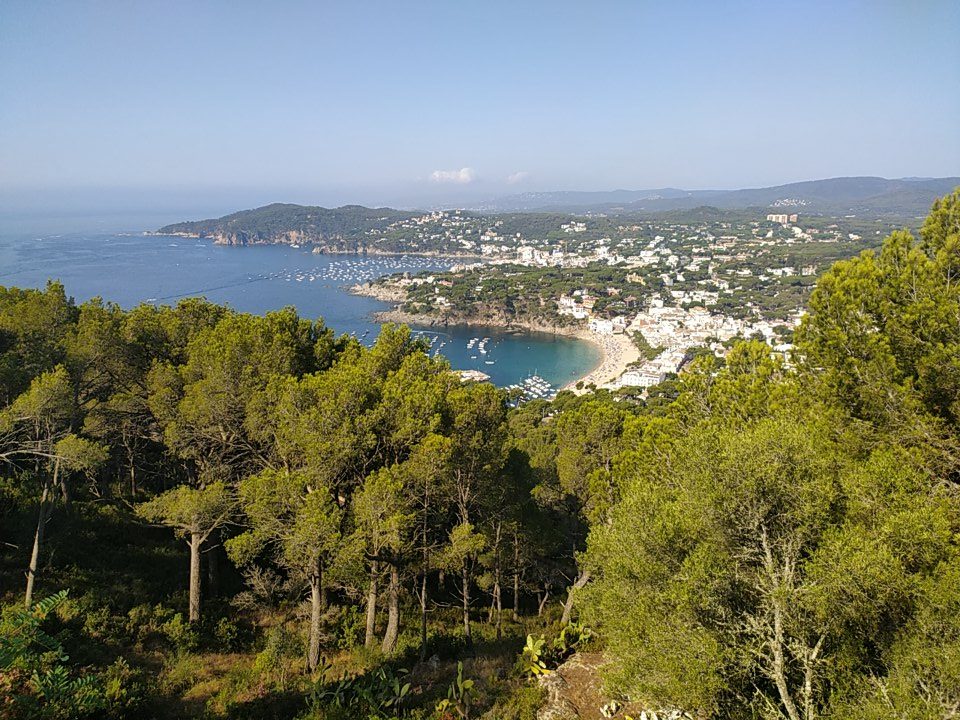The Costa Brava is undoubtedly one of Europe’s key cycling destinations. Found in the north-eastern corner of Spain this region is geographically very compact which means many great rides are all in striking distance from a few key centres. Girona is the main hub and being quite central makes it a good starting point for most. It is also only a 1.5hr drive from beuatiful Barcelona so an international airport is relatively close-by. From Girona it is also possible to easily branch out into the neighbouring medieval villages and coastal towns.
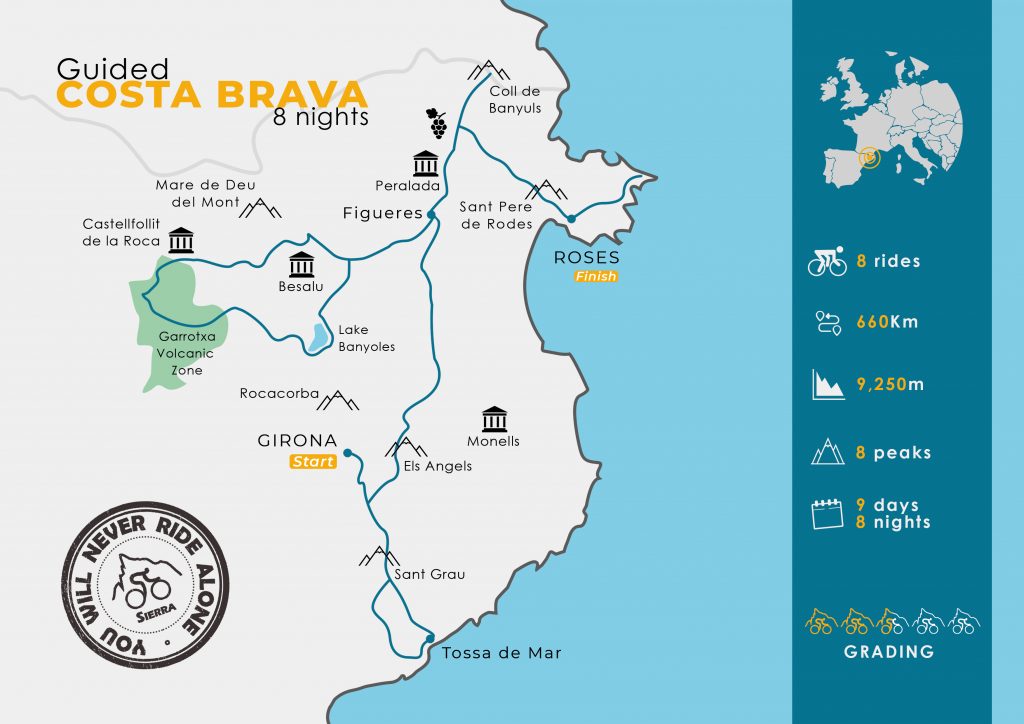
Another major attraction is the weather. Why do you think approximately 100 professional cyclists decide to call the Girona region home? Road cycling is basically possible all year round though we prefer the April to June and September to November periods. There is nothing wrong with July/August but being the main summer holiday months in Europe it is often crowded and there is more traffic on the roads.
When it comes to straight out climbing potential Costa Brava is not the French Alps/Pyrenees or Italian Alps! However, for many that is also one of its main drawcards. The main road cycling peaks near Girona are typically less than 1000m altitude which usually means no snow-capped mountains. The region though still has very good climbing potential but it is fair to say that road cyclists who prefer shorter climbs and undulating roads are going to be in their element. There are many 5-8km long climbs scattered across the entire Costa Brava region (Els Angels, Santa Pellaia, Sant Grau, Sant Pere de Rodes, Coll de Banyuls & Col de Bracons to name a few). With this type of cycling terrain, the great year-round weather and the busy July/August summer period we know where we like to ride and train to kick start our European pre-season or to prolong our European summer cycling opportunities!
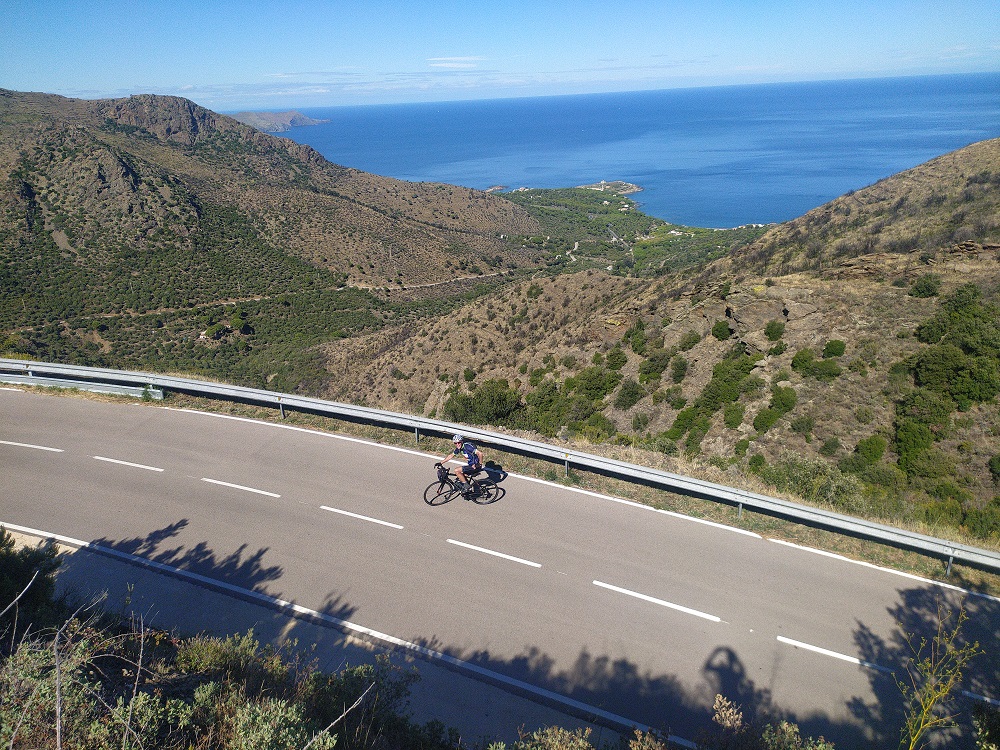
Quick Geography Lesson
The main zones of the Costa Brava (especially when it comes to road cycling) can be divided into El Girones, La Baix Emporda, L’Alt Emporda, Pla de l’Estany and La Garrotxa. Each región has something special to offer when it comes to road cycling.
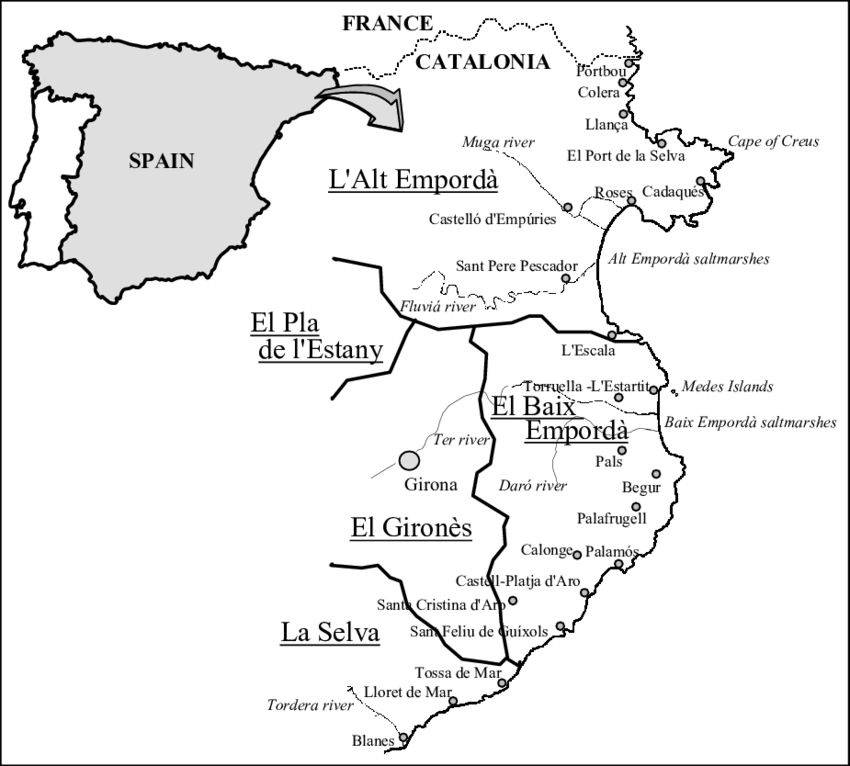
Girona, part of El Girones zone, is a city of approximately 100,000 inhabitants in northern Catalonia (Spain). Much of the old quarter of this medieval city has been preserved (founded by the Romans in the 1st Century BC) and is often referred to as the ‘City of the Four Rivers’. The historic centre is full of reminders from the Romans, Arabs and Jews. Nearby cycling climbs to get familiar with include Els Angels and Santa Pellaia in Les Gavarres mountain range.
Many would have also heard of Lake Banyoles which is located 30km north of Girona capital. It was used during the 1992 Barcelona Olympics and is a natural lake located in the Pla de l’Estany region. The lake is approximately 2100m by 750m with an average depth of 15m that in several points is as deep as almost 50m. It is located in a natural tectonic depression. Lake Banyoles and its many cafeterias and restaurants on the eastern shore are the perfect place to either re-charge your batteries before attacking the adjacent Rocacorba climb or for celebrating your achievement.
As the name suggests, Volcanica de la Garrotxa Natural Park, is an area of extinct volcanoes which is another road cycling paradise. Castellfollit de la Roca is one of the most picturesque villages in La Garrotxa. Its church and houses cling to the top of a spectacular basalt rock flow escarpment. From Castelfollit the Oix-Beget set of linking climbs is a good place to start on very quiet roads. The climb with most prestige is arguably Mare de Deu del Mont and we also like Coll de Bracons. From La Garrotxa it is also possible to head further north in search of the Spanish/French Pyrenees border (some big climbs are there but that’s a topic for a future post).
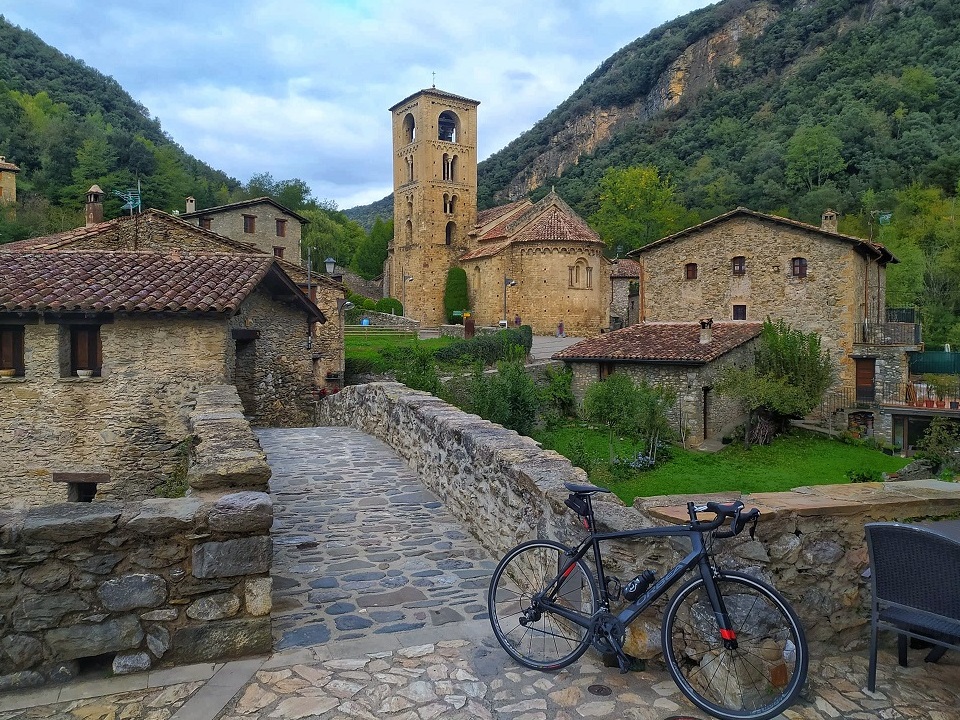
La Baix Emporda is directly to the south and east of Girona and includes many coastal ‘touristy’ townships. At times there can be more traffic and mass tourism but don’t let that put you off. Away from the busy months or even an early morning escape can still see you screaming along the Mediterranian coastline with a smile from ear to ear. The Sant Grau climb linking Girona to the coast is our pick and from Tossa de Mar to Sant Feliu this in general is a wonderful stretch of road!
L’Alt Emporda region is the last described here but definitely not the least. This region takes in coastal towns, interior mountains and incredible coves and capes that must be discovered by bike. The Gulf of Roses we think is a good starting point to discover L’Alt Emporda and the area between Peralada and Figueres is also very good. There are also many great wineries putting L’Alt Emporda on the map! When it comes to cycling up to the Sant Pere de Rodes Monastery you have two possible approaches which offer totally different perspectives. Be sure to check them both out. Coll de Banyuls is also a quiet road up to the Spanish/French border and perfect for an ‘easier’ climbing day.
Our 3 Favourite Cycling Climbs!
When you cycle Costa Brava you are going to hear the names of literally dozens of ‘cols’. It is not always easy to pick favourites but we can’t go past Rocacorba, Mare de Deu del Mont and Sant Pere de Rodes for the challenges the three present.
Mare de Deu del Mont (Alta Garrotxa región)
For most of our Costa Brava cycling tours the most challenging day on the bike is the climb to Mare de Deu del Mont. The climb is full of surprises and changing landscapes at every corner. At 1085m altitude the peak is the highest point in the eastern sector of the mountainous territory named Alta Garrotxa. The summit offers 360° degree views from what is our favourite viewing platform on the Costa Brava. The energy expended we believe is well and truly worth it. From Cabanelles it is an 18km climb with a 5.2% average gradient up to this Catalan sanctuary. It is an enjoyable climb on roads in the picturesque Alta Garrotxa mountains. The lower part is mostly in trees, but the scenery opens up towards the top, with some fine views. The first half of the climb is relatively gentle but the second half has its challenges with 13-14% short ramps to contend with. The road also narrows in the second half so take care and be attentive to traffic. At the top you have ‘Restaurante Bar Hostatgeria’ but take note that it is usually closed on Tuesday’s and Wednesday’s (even in peak season).
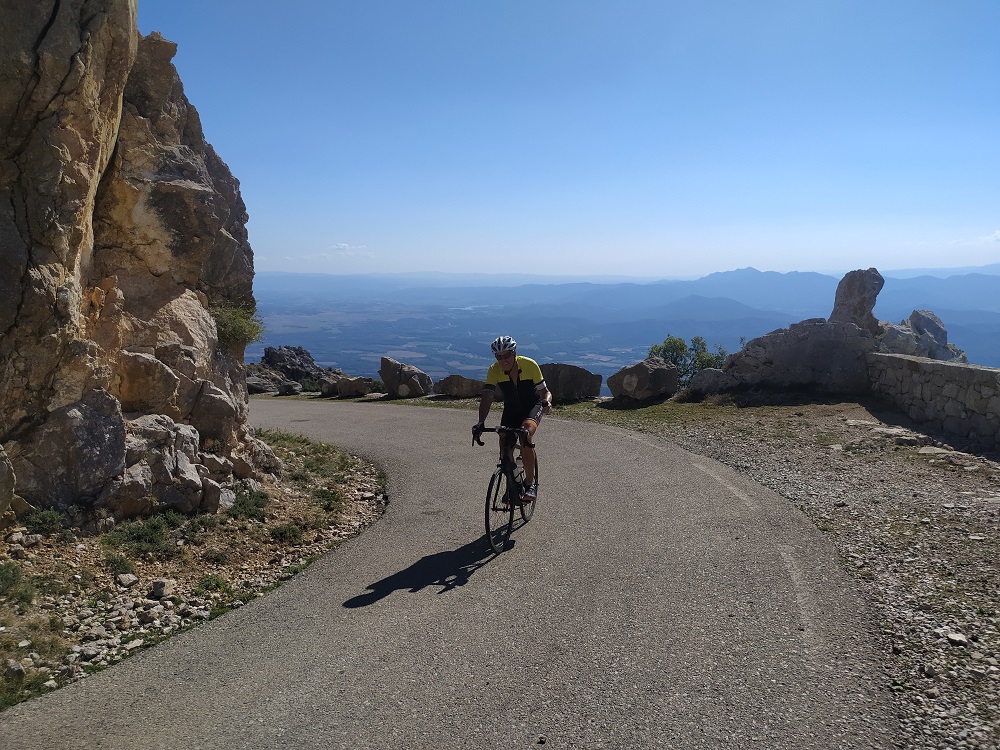
Mare de Deu del Mont can also be climbed from the small hamlet Beuda. Just quietly, this western approach is a great challenge. The first part of the climb from Beuda is a section of road which is 5.5km long and for the most part ranges between 7.5-9% grade. The road is narrow but reasonably well asphalted. Climbing is not the main issue though. If you decide to descend it then always apply safety first. It is a road that is hardly transited so when a car does pass it can be a surprise. So, on the narrow corners be vigilant but the main message is that if you take care and keep control of your speed then you can safely descend it. With 6.5km remaining to the Mare de Deu del Mont summit this road from Beuda connects with the main eastern approach (described above) from Cabanelles. The western approach in our opinion is an excellent option because it means that from Besalu and Beuda you can also climb Mare de deu del Mont without accessing the busy N260 road which links Besalu and Figueras.
Rocacorba (Pla de l’Estany región)
Rocacorba has become famous in recent years with professional riders using the climb for their hill interval sets. While the 13.5km is characterised by a 6% average grade the statistics hide some vicious ramps. The steeper gradients for example kick-in during the second part of the climb. There are 3 difficult km with no respite and the grades constantly sit between 9-11%. Take on this beast and just like the pro’s you too can rate your form. Pro’s are searching for sub-30 minutes, trained recreational riders sub-60 minutes and local master’s riders often set their target time as their age plus 10 minutes. How fast can you go? Whatever the case, at the top be sure to congratulate yourself on what is a wonderful achievement.
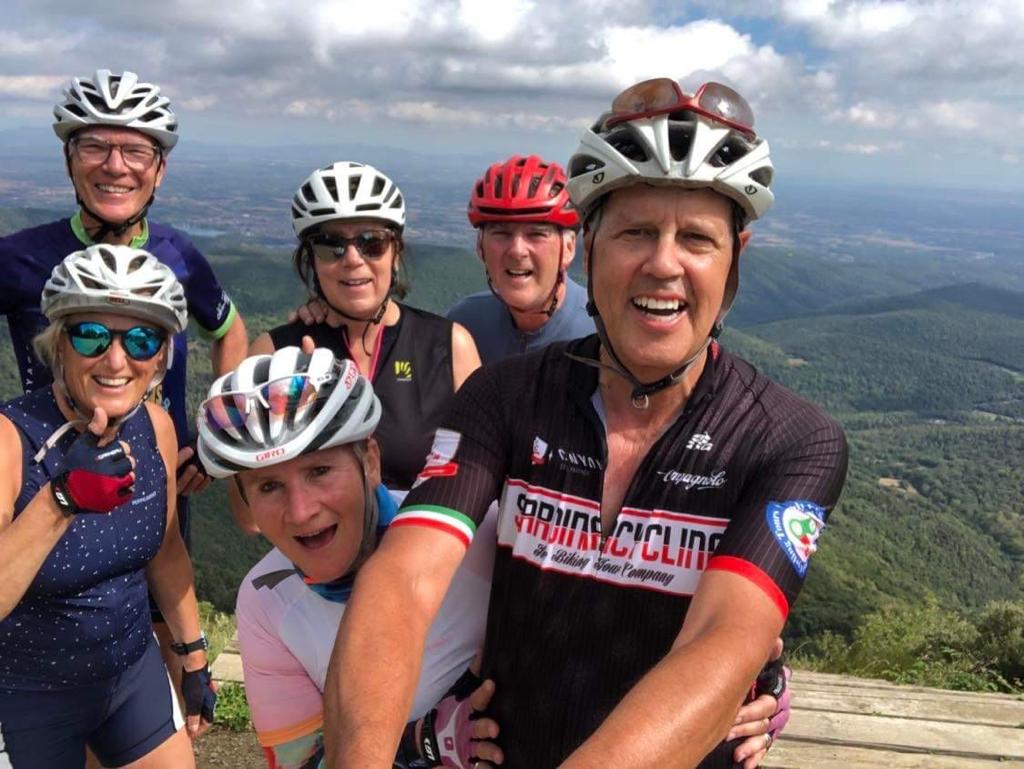
For difficulty on the Costa Brava, Rocacorba and Mare de Deu del Mont are in direct competition. Please note though that the overall experience is completely different in our opinion. Mare de Deu del Mont has the 360 degree views, sizeable car park and bar at the top while Rocacorba only has a lone telecommunication tower and small viewing platform overlooking Lake Banyoles. Rocarcorba though is only a 30km warm-up ride to the base from Girona which we have to say is a real advantage. There is time to put in a solid effort and still get back to Girona for lunch! If you are late to start though don’t worry as you can descend directly to Lake Banyoles for your lunch stop. In the upper section of the climb a Rocacorba neighbour (during the 2022 season) set up an ‘honesty-system fridge’ at their property so that also might help anyone on the brink of bonking!
Sant Pere de Rodes (L’Alt Emporda region)
The climb though which the Sierra guides are always lining up for is Sant Pere de Rodes. This corner of the world is close to Cadaques/Cabo de Creus which is the most eastern point of the Iberian Peninsula and what seems to be only a stone’s throw away from the French border. On tour we often save this climb for last because the arrival at the picturesque Benedictine Monastery near the summit with its curving roads and spectacular coastal views all combine to create a memorable experience. The most difficult of the two possible ascents starts from the lovely beachside town of El Port de la Selva. Here the ‘Sant Pere’ climb begins from sea level and the views of the Mediterranean follow you all the way to the very top!
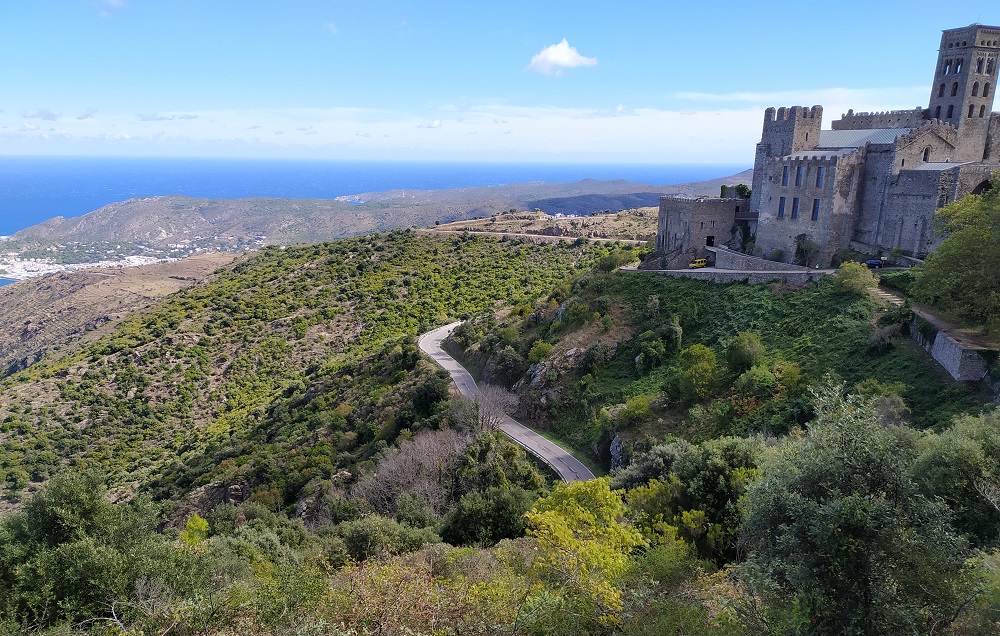
We think ‘Sant Pere’ is the most scenic climb in the entire Costa Brava region and that is saying something considering the natural beauty of Costa Brava! The 7.4km of winding roads from practically Km 0 offer majestic views down to the Mediterranean Sea. The 6.5% average grade seems manageable but the first 6km never drop below 7-9% average grade with many shorter pinches to also contend with.
The other approach to Sant Pere de Rodes starts from the inland town of Vilajuiga. This climb doesn’t get nearly as much attention as that previously mentioned (i.e. Port de la Selva). But if you have time we really recommend you climb both sides up to the Monastery. Either way you won’t be disappointed! The flowing descent from the summit down to Vilajuiga is also something to savour!
A Few Trade Secrets
The Costa Brava is home to many secret detours or ‘rincones’ (remote areas) which we believe really enhance the road cycling experience. We could write a small book, but here are a few you should keep in mind!
The French Connection
All routes designed on the Costa Brava are noteworthy but there is one that we particularly like and it affectionately goes by the name ‘The French Connection’ amongst our team. The riding begins and finishes on L’Alt Emporda but crosses into France for a good stretch of low-lying Pyrenees and coastal roads. It is a quality ride and also comes with historical significance. The crossing from Spain to France heads up and over the relatively ‘soft’ Coll de Banyuls. It is a 9.5km climb on quiet roads which only rises up to approximately 340m altitude. While it is a gentle climb for the most part there are four or five short pinch points with 10% ramps. If you are doing an up and back ride only then take note of the cattle grids on the way up and remember to slow down for them on the way down.
During late 2022 the border was closed for traffic (massive concrete road blocks in place and which don’t appear to be going anywhere fast) but bikes can easily pass. The views over to France which overlook Banyuls-sur-Mer are first-class. The first couple of kilometres on the French side of Coll de Banyuls are very steep, tight corners and narrow so safety first please! Also, keep the steepness in mind if you have to ride back over to Spain again. The final 2km include ramps that nearly hit 20% grades resulting in a tough test. The below ride map though continues through to France so you can skip these insane grades and simply focus on getting down safely.
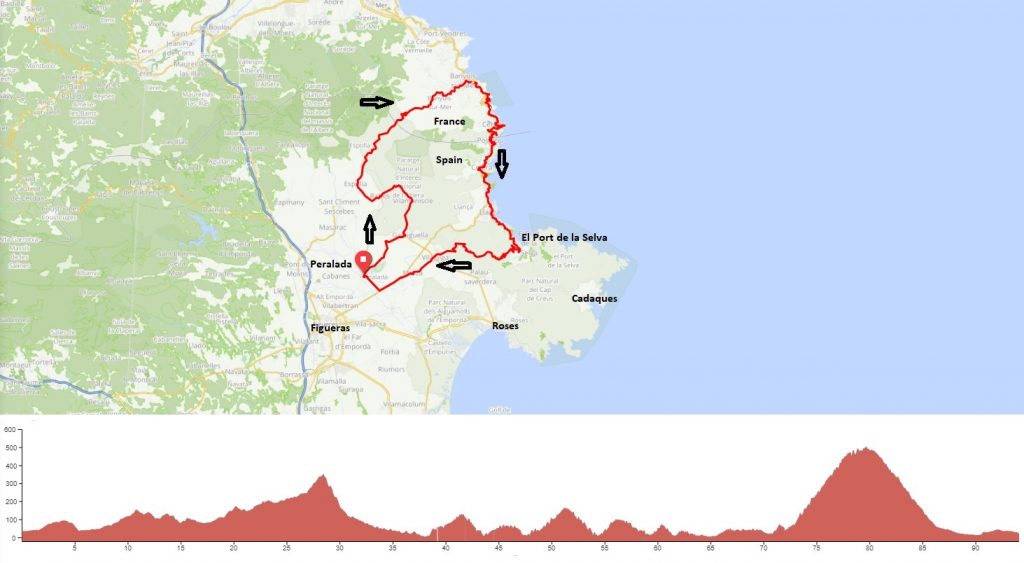
Time for some history – Between the end of January and the beginning of February 1939, it is estimated that some 350,000 Spaniards fled to France through the Pertús, Coll de Banyuls and other points of the Alt Empordà region of Costa Brava. On 26 January 1939, the rebel troops of General Franco occupied Barcelona. The Spanish Civil War had practically come to an end and the victory of the Rebel Army was imminent. But for all those people who had fought alongside the democratic legality embodied by the Republic, a period marked by repression and silence began. To avoid this situation, thousands of citizens, both military and civilian (men, women and children), had to flee and leave their work, their homes and families. As you reach the ‘Banyuls’ summit it is worth reflecting on the history but also marvelling at this iconic ‘rincon’ on the Spanish/French border!
Back to the route – once down in Banyuls-sur-Mer (France) there is about 15km of cycling which hugs the coastline all the way back to the Spanish border (Coll des Belitres). Twenty kilometres later you are in El Port de la Selva and the base of the more difficult ‘Sant Pere to Rodes’ ascent (as previously described). Finishing this loop ride on what is a gem of a climb and then riding down to the Gulf of Roses beaches or through to the Peralada/Figueras townships rounds out what we think is an excellent day on the bike.
Worthy of a Special Mention – Coll de Bracons
Hidden away in the quiet Vall de Bas (Osana region of La Garrotxa) is this special climb which doubles as a great escape into what is a picturesque valley. The valley is surrounded by mountains that peak at 1500m elevation and the area is very lush and a paradise for agriculture and livestock raising. It would be fair to say that most travellers don’t venture into this corner of Costa Brava (despite it only being a 50km drive north-west from Girona). However, the locals know it only too well thanks to the annual ‘Terra de Remences’ gran fondo ride. This event will be held on 14 May 2023 and there is a 100km loop (1280m elevation gain) and a 175km loop (2600m elevation gain) to choose from.
Coll de Bracons is one of the major climbs on-route and from Can Trona its 8.4km at 7.8% average grade will get you sweating. The first half of the climb ranges between 4-7% so you can guess what the second part looks like. Basically, there is not too much asphalt over the final few kilometres below double digits!
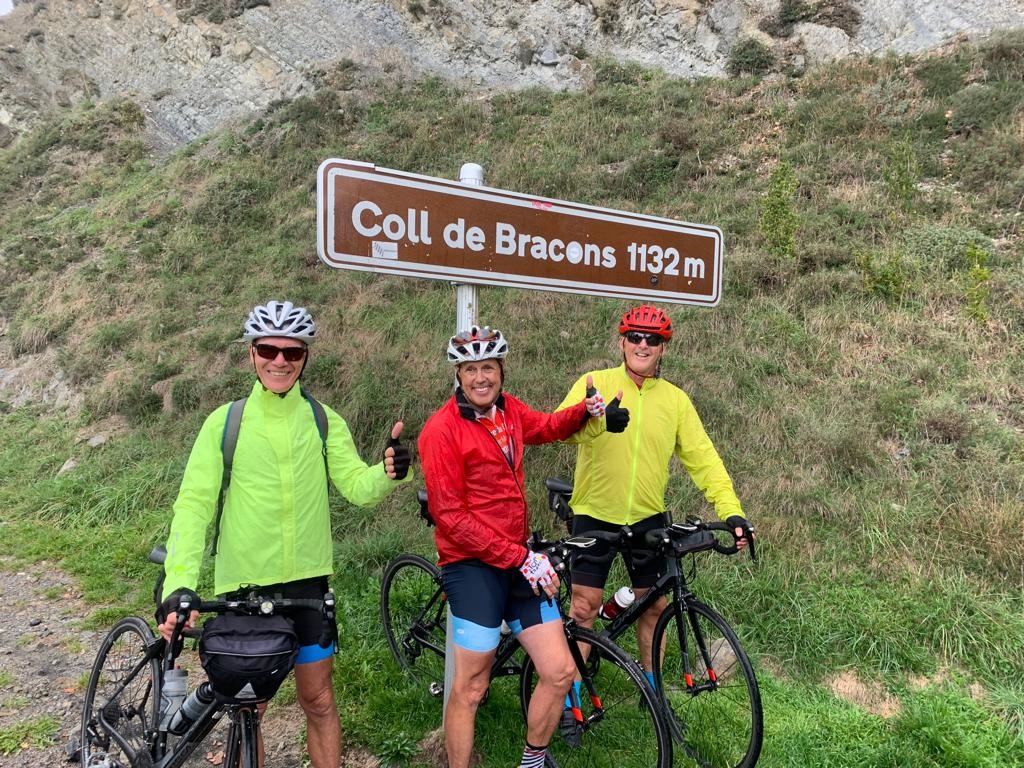
Gateway to the Pyrenees
The Costa Brava in many ways can also be considered as a gateway to the Pyrenees. We are not going to go into detail during this blog but at least we have made the reference. If you have a vehicle to move around the Costa Brava then there is nothing stopping you from a trip to ‘Vallter 2000’ and ‘Coll de la Creueta’. Two totally different climbs with equally varying ride statistics but excellent cycling adventures respectively.
How to get there?
Most Costa Brava cycling expeditions kick off in Girona. There are many transport options to the city centre and it is the perfect place to get over any jet lag and fine tune the bikes. If you happen to be joining a Sierra tour then our guides and 9-seater vans will always be close by to help. If you have selected a guided Sierra tour then the Barcelona-Girona and vice versa transfer price (for you and your bike bag) is already included.
All other cyclists visiting Costa Brava will need to assess their transfer options and this is usually best done based on whether you will be arriving with or without a bike box. Bus and train options, whilst possible, are often more difficult and stressful when travelling with a bike box. If you are coming into Girona train station or Girona airport with your bike then a taxi will be quick, cheap and easy. However, you and your bike box via taxi from Barcelona Airport to central Girona will most likely come with a 200 Euro price tag.
Many cyclists visiting the Costa Brava often spend a few initial days in beautiful Barcelona. If you are travelling without a bike box then from the Catalan capital we can recommend public transport services. Buses leave from ‘Estacio del Nord’ and the Sagales bus company has one-way tickets from approximately 20€. A bike box is treated as over-size luggage and an additional standard ticket price is also required. Whether your bike box can be stored away will also be subject to availability in the underneath luggage compartment so this bus option comes with its own challenges for travellers with bike boxes.
If you prefer train travel, then from Barcelona-El Prat Airport you will first need to find the RENFE station at terminal T2 (there is a free airport bus between T1 and T2). From T2 you can catch the metro line to the central Barcelona-Sants train station (about 5€ for the 20-minute one-way trip). A taxi from Barcelona-El Prat Airport to Barcelona-Sants train station is more likely to be around 40-50 Euro.
Now that you have arrived to Barcelona-Sants train station you can board the high-speed AVE train to Girona city centre. One-way tickets start from around 20€ and the trip usually takes about 40 minutes. Be careful with the high-speed AVE train though as there are strict luggage requirements. RENFE allows one large suitcase only so if you also arrive with your bike box you will encounter a problem.
If you have luggage and a bike box then a good alternative is to make your way to nearby ‘Passeig de Gracia’ train station in the Barcelona city centre. Take a regional train from here which has no luggage restrictions, leaves every hour, costs less than 10€ and typically takes between 75-90 minutes to central Girona.
Where to Stay?
We have already mentioned that Girona being a central hub is a great place to stay for your Costa Brava holiday. There are many hotels and apartments to choose from and the old town with its many cycling focused coffee shops, its plazas, bars and restaurants makes it a very comfortable option.
If you are longing for the sea though, then why not consider a stay in Calella and/or around the Gulf of Roses. We think you will also be impressed by El Port de la Selva sitting at the base of the Sant Pere de Rodes monastery.
Of the medieval villages we like Peralada as a potential cycling base for a few good days of exploring. Peralada is located in the “Alt Empordà” and its origins go back to an Iberian settlement approximately from the year 500 B.C. Today, it is predominantly an agricultural and wine-growing area, producing a great variety of wines under the Empordà D.O. It has also a small population with less than 2000 inhabitants.
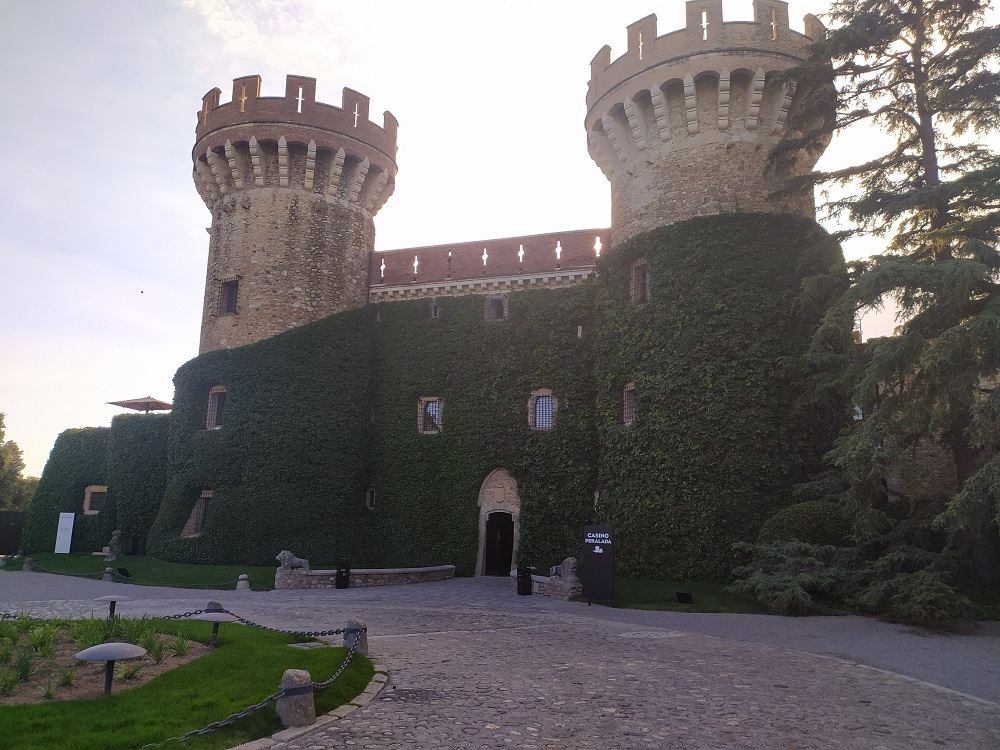
Costa Brava – It’s not all about the bikes
Well actually it is! Who were we trying to kid? But jokes aside, it is possible to design any ride on the Costa Brava so it passes a medieval village, a Dali inspired attraction, a top-shelf winery or more recently a micro-brewery or ‘sidreria’ (cider anyone?).
As you move away from Girona there are many jewels across the entire Costa Brava region to enjoy. The famous and local surrealist artist Salvador Dali has well and truly left his mark (check out Pubol, Figueras and Cadaques), striking medieval villages and monuments are scattered over the region and the Catalan cuisine is also incredibly appetising!
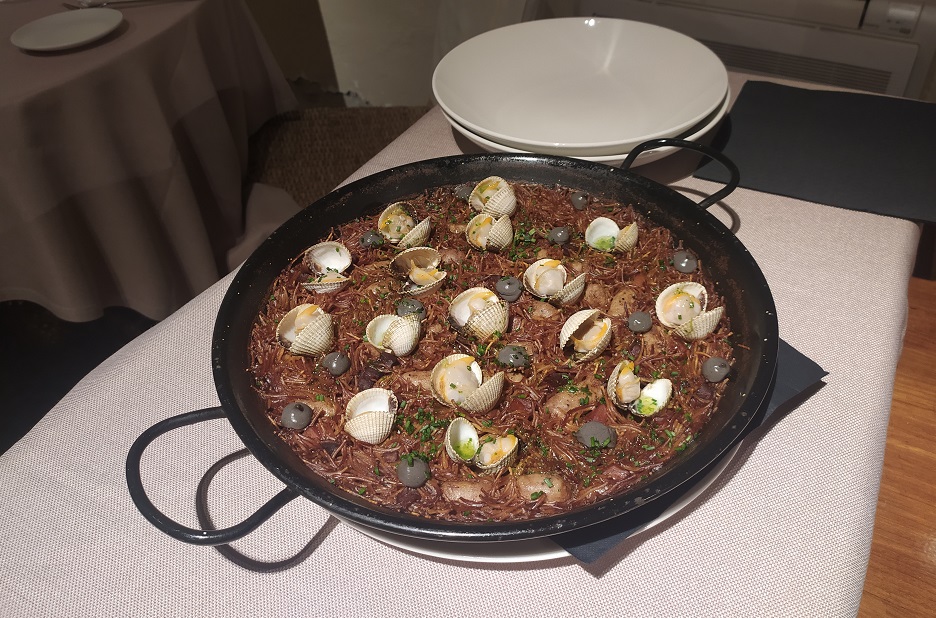
Medieval Villages
As mentioned, the Costa Brava contains enchanting towns like Monells (El Girones , Peratallada and Pals (La Baix Emporda), Peralada (L’Alt Emporda) and Besalu (La Garrotxa).
Monells is a small medieval town located in the Baix Emporda region and its name comes from Villa Mulinnensis, as there were many mills in the area. The first written records date back to around the 10th Century and sections of the old medieval wall are preserved. We recommend that you hop off your bikes for a while and walk the cobblestone streets of the town observing its architecture, stone arches and its squares mainly in Gothic style. The main square ‘Plaza Jaume I’ is enclosed by stone houses and full of terraces where you can have a drink. ‘El Roura Blanch’ is a real favourite with the locals.
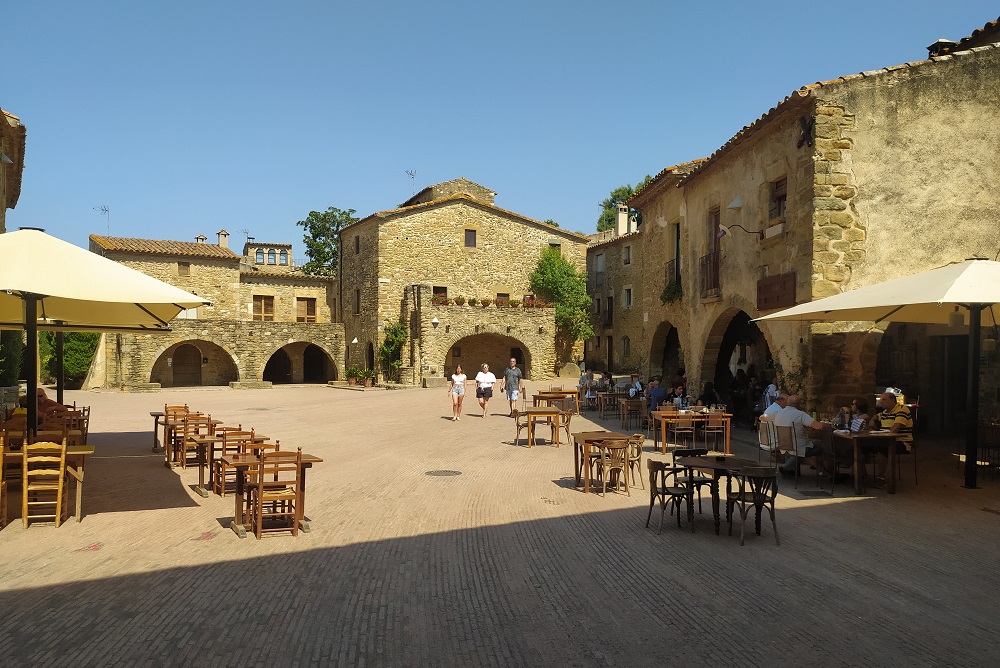
Peratallada is a magnificent architectural site presided over by an elegant castle and surrounded by defensive walls and a moat, which has managed to perfectly preserve the medieval atmosphere of its origins. We like to cycle in from its main entrance found to the east of the town and out by the northern archway (Portal de la Verge) which joins the road towards Canapost.
Besalu is another classic town in La Garrotxa with a long history. The first signs of settlement date back to Iberian settlements 1000 years B.C. It later became an important urban centre for the Roman Empire, however, its medieval past is what makes it worth visiting today. It is difficult to find a town with so much history per square metre. It is one of the best-preserved medieval centres in all of Catalonia. The Romanesque bridge is perhaps the most important element of the village and the best access to visit the old part of the town. It is a 105m long bridge with an impressive tower and which has seen a battle or two!
Salvador Dali
Figueres is fondly known as the home of Salvador Dalí. This town in L’Alt Emporda, between Besalu and Roses, has deep Catalan roots. Visitors have the chance to visit the Dalí Theatre-Museum which has become one of the main cultural places in the city. Designed by the artist himself, it holds many of his most important works, and which allows you to take a trip through the career of the man considered a master of Surrealism. The site was extended with the Torre Galatea, where the artistic genius died. Let us know what you think about all of the giant eggs on the roof!!!
The story goes that Dali had also always promised his wife Gala that he would buy her a castle. In 1969 the dream became reality when he bought her Castillo de Pubol (25km north-east of Girona). It was in bad condition so the artist you could say ‘got to work’. A visit to this Dali renovated castle is for many an even better experience than the above-mentioned Figueres museum.
At the head of Cadaqués bay is its historic quarter, with a Mediterranean air and deep seaside flavour. The source of inspiration for internationally famous painters and artists for decades, today this centre enjoys an intense cultural life, as witnessed by its many museums and art galleries, among which the Salvador Dalí House-Museum which is outstanding.
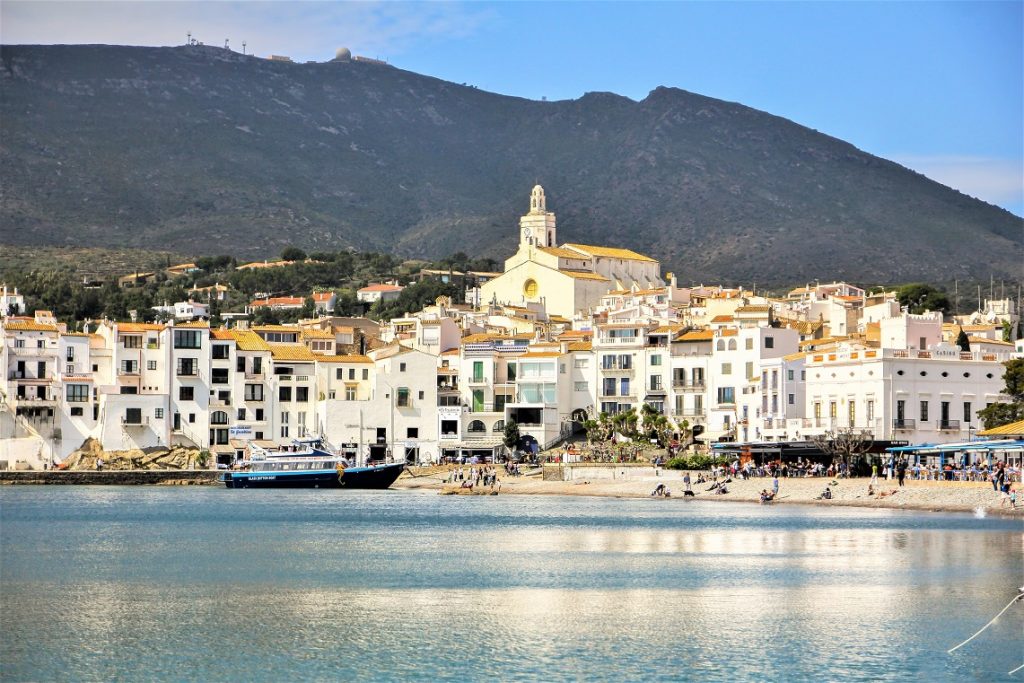
Wineries
From La Baix Emporda to the south to L’Alt Emporda in the north there are some wonderful wineries that are really going places. Depending on where your cycling adventure takes you be sure to try and organise a visit to at least one of the below wineries:
Finca Bell-Lloc: Located near the town of Palamos (La Baix Emporda) this estate (‘finca’ in Spanish) is many things all rolled into one. The comfortable accommodation settled amongst the beauty of the forested estate, the ruins of the Vila Romà Castle on-site, the underground wine cellar for tastings and the acclaimed restaurant combine to create a wonderful experience. The final kilometre entry to the ‘finca’ follows a maze of compacted dirt roads accessible by road bike. As you park your bike below the outdoor terrace you know that you are in for something special!
La Vinyeta: Whenever we are cycling near medieval Peralada we try to combine a visit to this modern wine cellar. La Vinyeta is a small vineyard and olive farm situated at the heart of the L’Alt Empordà. The origin of this project dates back to 2002, when two old Carignan and Grenache vineyards – aged between 50 and 75 years – were purchased. In 2009, La Vinyeta became one of the first wineries to adopt an environmentally friendly cultivation system. We hope you can enjoy a detour to ‘La Vinyeta’!
Why ride Costa Brava with Sierra?
The advantage of joining a Girona & Costa Brava cycling tour is the flexibility we provide regarding available options. Being based in Spain we offer fully guided tours through to more economical partially guided and self-guided adventures. You can jump on a tour with scheduled dates as listed on the web or get a private group together and set your own dates. Below you will find some background information in relation to how each tour type works. The choice is then up to you!
Fully Guided Cycling Tours: These are group travel experiences where individual travellers sign up to a web-listed package with a set itinerary and set dates (11-19 May and 17-25 October during 2023). Clients from all over the world sign up via the online booking form and we organise the rest. The formed group is led by the Sierra team from the start to finish of the tour. There is a lead cycling guide out on the road with the group at all times and a following support van with experienced driver/mechanic. The support van carries a full-set of bike tools and parts, spare wheels, complimentary food and drink and also guest day packs with additional clothing, towels, etc. The vans also come with roof racks for transporting up to 10 bikes so if you are having an off-day the van ‘is your friend’ as Sierra tour leader Jorge likes to say.
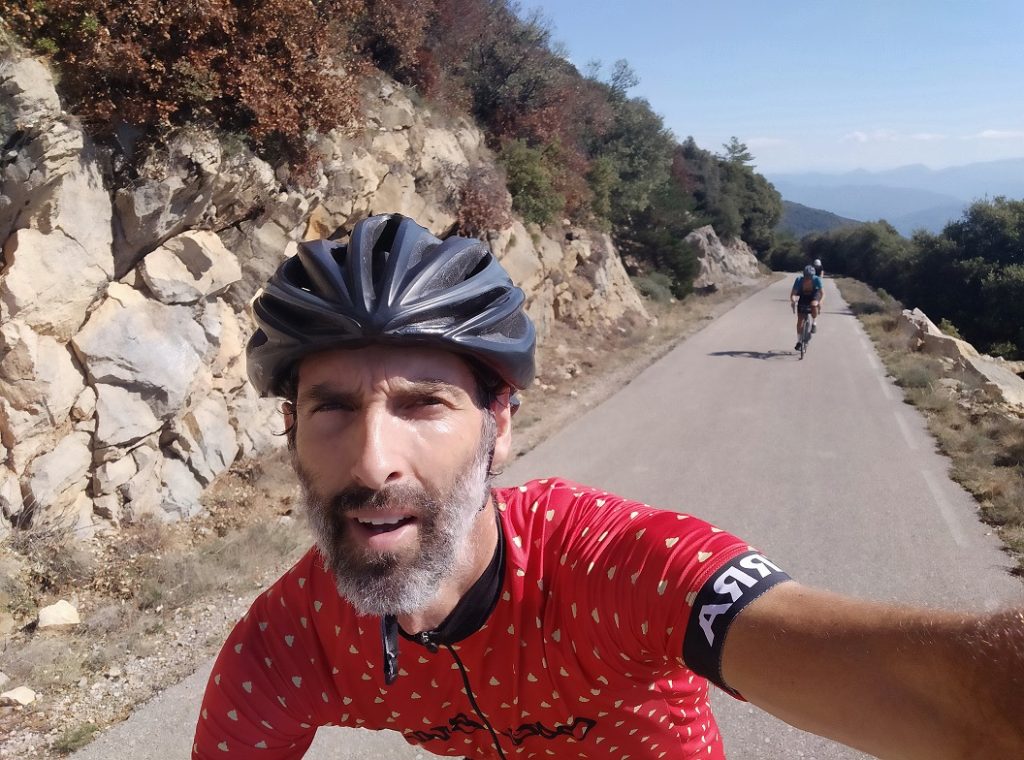
Self-Guided Cycling Tours: Sierra has rolled out many self-guided tours for guests who are more experienced travellers who love making their own adventure, typically enjoy travelling in small groups with friends or family (minimum 2 clients) and/or are looking for a more budget friendly tour option. In such instances, the Sierra office prepares the tour itinerary, books the accommodation and nine times out of ten also organises the hire bikes (which could be hybrid, road bike or both of these forms of e-bike. During 2023, Sierra has a variety of 6 night, 9 night and 12 night Girona & Costa Brava Self-Guided tour itineraries to choose from.
The Sierra self-guided formula for success includes a local guide that meets you at the initial hotel in central Girona. At this time there is the bike hand-over (which includes fitting), small toolkit, floor pump, chains/padlocks and e-bike charges (if necessary). A detailed briefing going through the client booklet and what you all have in store over the coming days is also conducted. There is no guide with the group during the daily rides but what Sierra does offer being local is a 24hr emergency support phone number in the event their clients strike any issues.
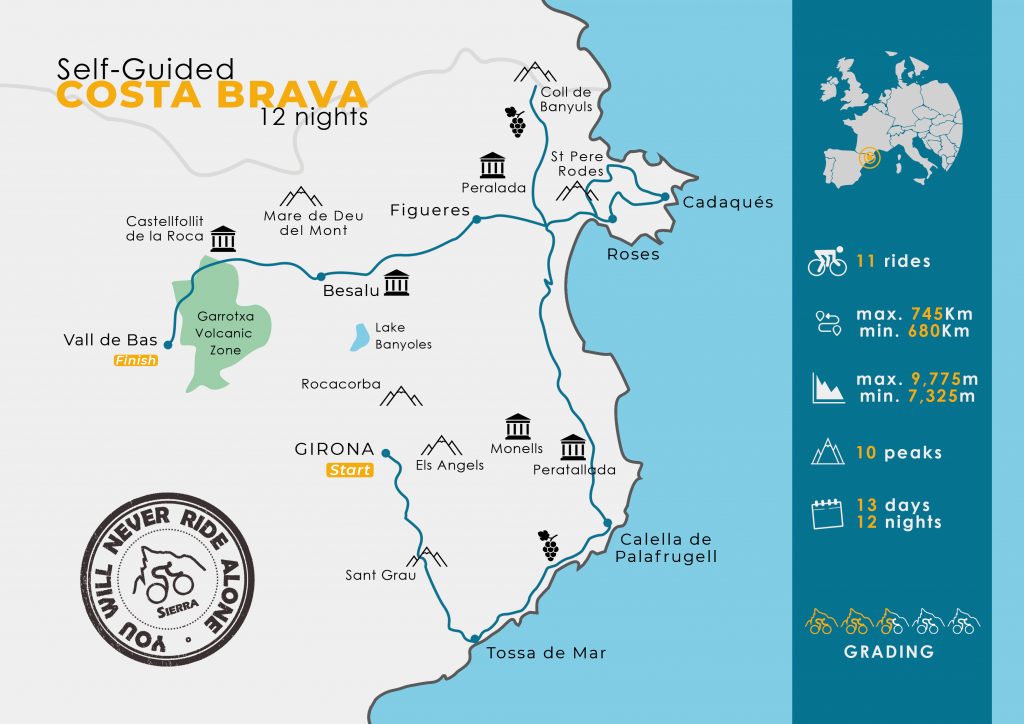
Go Private tours: The guided private tour involves rounding up a group of friends and stating the number of tour days and the specific tour dates you require. You will be assigned a Sierra team with lead cycling guide and support driver/mechanic. However, perhaps you prefer the concept of ‘Partially Guided’. It is a private group experience where you follow a set itinerary prepared by Sierra for a specific duration and your selected preferred dates. What is different though is that there is no lead cycling guide on tour. The Sierra guide in this case is the support driver/mechanic. A van will follow you providing the daily ride assistance you are looking for. Partially guided is perfect for those setting off on long challenging daily rides and who know too well the importance of having extra gear on-hand for the mountains and the need to have plenty of food and drink. At the same time, these types of riders are accustomed to riding in their own group, are comfortable using a Garmin and following pre-designed GPX files.
Costa Brava: the Final Word!
One of the great features about the Costa Brava is that you can make the cycling as easy or as difficult as you like. If easy rides are preferred then there are many bike trails available. They might not all be suitable though for road cycling (gravel bikes? – well that is what we have begun planning for the near future – stay tuned)! If you have some training in the legs then ‘medium-level’ rides out of Girona will see you tick-off fantastic 5-8km climbs such as Els Angels, Santa Pellaia and Sant Grau. For the more advanced or adventurous riders in the peloton you will be wanting to take on the more difficult challenges around the region including Mare de Deu del Mont, Rocacorba, Sant Pere de Rodes and Coll de Bracons to name a few!
Remember, it is also a long cycling season on the Costa Brava so choose your dates wisely. You will know if you prefer busy or quiet traffic conditions; cooler, warmer or hotter weather conditions and cheaper or more expensive accommodation prices (July/August – peak season prices for example).
In summing up, cycling through the Costa Brava guarantees you a variety of picture-perfect views. These will come from hilltop monasteries, spectacular lakes, small coastal coves, ancient volcanic landscapes (over 10000 years since the last eruption – phew!), breathtaking lookout points, beaches and serpentine roads along the Mediterranean coast. The combination of nature, history, architecture, gastronomy and well-maintained roads provide the perfect setting for creating what will be an unforgettable cycling experience. We hope this Costa Brava cycling guide serves to inspire your next Spanish cycling holiday!
